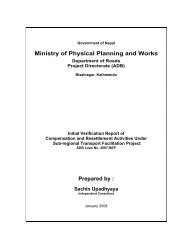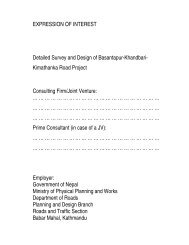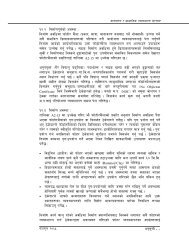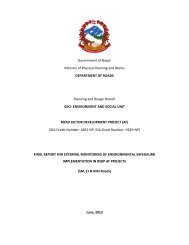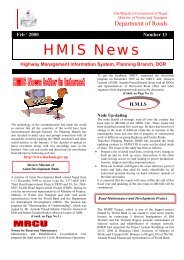Environmental & Social Management Framework - About ...
Environmental & Social Management Framework - About ...
Environmental & Social Management Framework - About ...
Create successful ePaper yourself
Turn your PDF publications into a flip-book with our unique Google optimized e-Paper software.
<strong>Environmental</strong> and <strong>Social</strong> <strong>Management</strong> <strong>Framework</strong>streams, rivers, and dams at some distance from the initial impact. Fresh cuts areoften vulnerable to wind and rain, instigating erosion. Similarly, haphazarddisposal of construction spoils, unsuitable locations of quarry sites and borrowpits, fresh quarrying and borrowing activities, construction carried out in rainyseason without proper water control and drainage facilities; and improperconstruction methods which leave soils exposed unnecessarily, etc. are alsoreason for erosion and possible consecutive landslides. The consequences oflandslides and soil erosion not only affect the safety and serviceability conditionof roads but also have chain effects on the farmers (loss of crops or farmland),land (degradation due to silt/debris deposition), water (degradation of quality),river and streams (change in regime), vegetation (loss and impact) and on otherinfrastructures like reservoirs (silting). The costs of correcting these problems areoften many times greater than the costs of simple preventive measures.The problem of road-associated landslides generally results from interactionbetween water flow and soil, both of which are disturbed by road construction.The situation gets worse if vegetation is also cleared. Improperly disposedconstruction spoil may worsen this situation. Fresh cut slopes and embankmentsare relatively more vulnerable to landslides and soil erosion, particularly due toimproper water management in the vicinity. During the construction period,instability, landslides and soil erosion problems may result because of:• steeper cut and fill (embankment) slopes and their construction qualities• environmentally hazardous disposal of construction spoils (e.g. near waterbodies or drinking water sources, wetlands, karstic landscapes, sensitivehabitats);• unsuitable locations of quarry sites and borrow pits (eventually leading touncontrolled, unaesthetic and hazardous dump sites and mosquito breedinggrounds)• rash quarrying and borrowing activities• construction carried out in rainy season without proper water control anddrainage facilities; and• improper construction methods which leave soils exposed unnecessarily, etc.During the operational phase the instability, landslides and soil erosion result notonly from the road and its structures but also from heavy rainfall, seismicactivities and from general vehicle movement on the road. Common problemsassociated with slope failures are:- blockage or deficiency drainage structures,- modification of water paths leading to concentrated flows (mayalso be caused by blocked ditches),- high gradient in cut or fill slopes, and- cleared areas which have been left without re-plantation or otherappropriate rehabilitation measures.d. Hazards due to Spoil DisposalIn hills and mountains, large amounts of spoil can be generated during roadconstruction. Sometimes it is difficult to keep balance between cut and fill, andhaulage to disposal site will be expensive. Thus, spoils are often side-tipped,which invites most hazardous environmental and social impacts. Suchconstruction practices overload instable slope areas triggering slides, causevaluable soil erosion, destroy vegetation, cause hazard to settlement at downhillside, disrupt natural drainages and pollute water sources etc.April 2007 Chapter 4-9



![j:6 ]zg cfof ]hgf](https://img.yumpu.com/51286794/1/190x245/j6-zg-cfof-hgf.jpg?quality=85)

![x'nfsL /fhdfu { cfof ]hgf](https://img.yumpu.com/50581959/1/190x245/xnfsl-fhdfu-cfof-hgf.jpg?quality=85)
